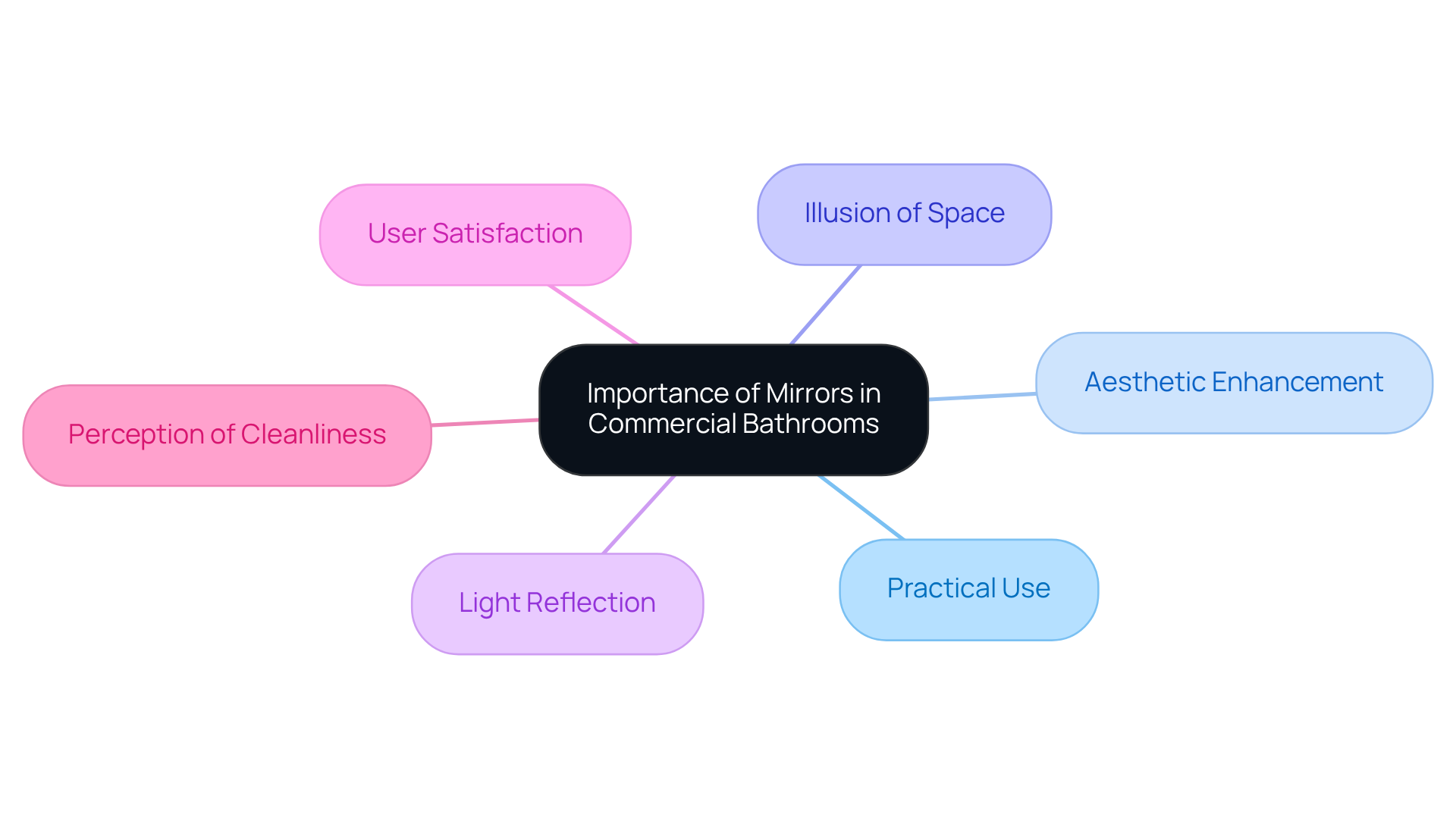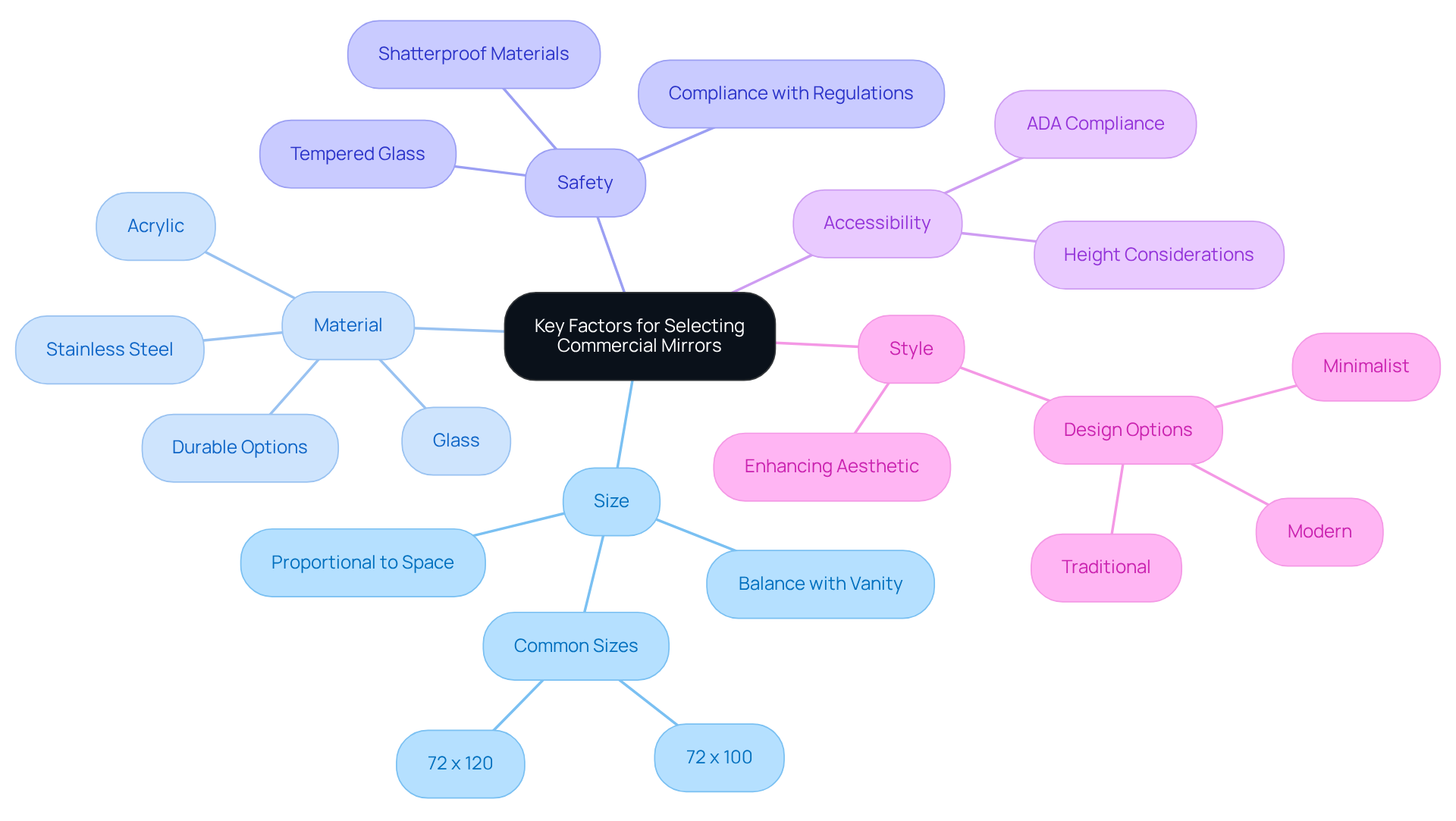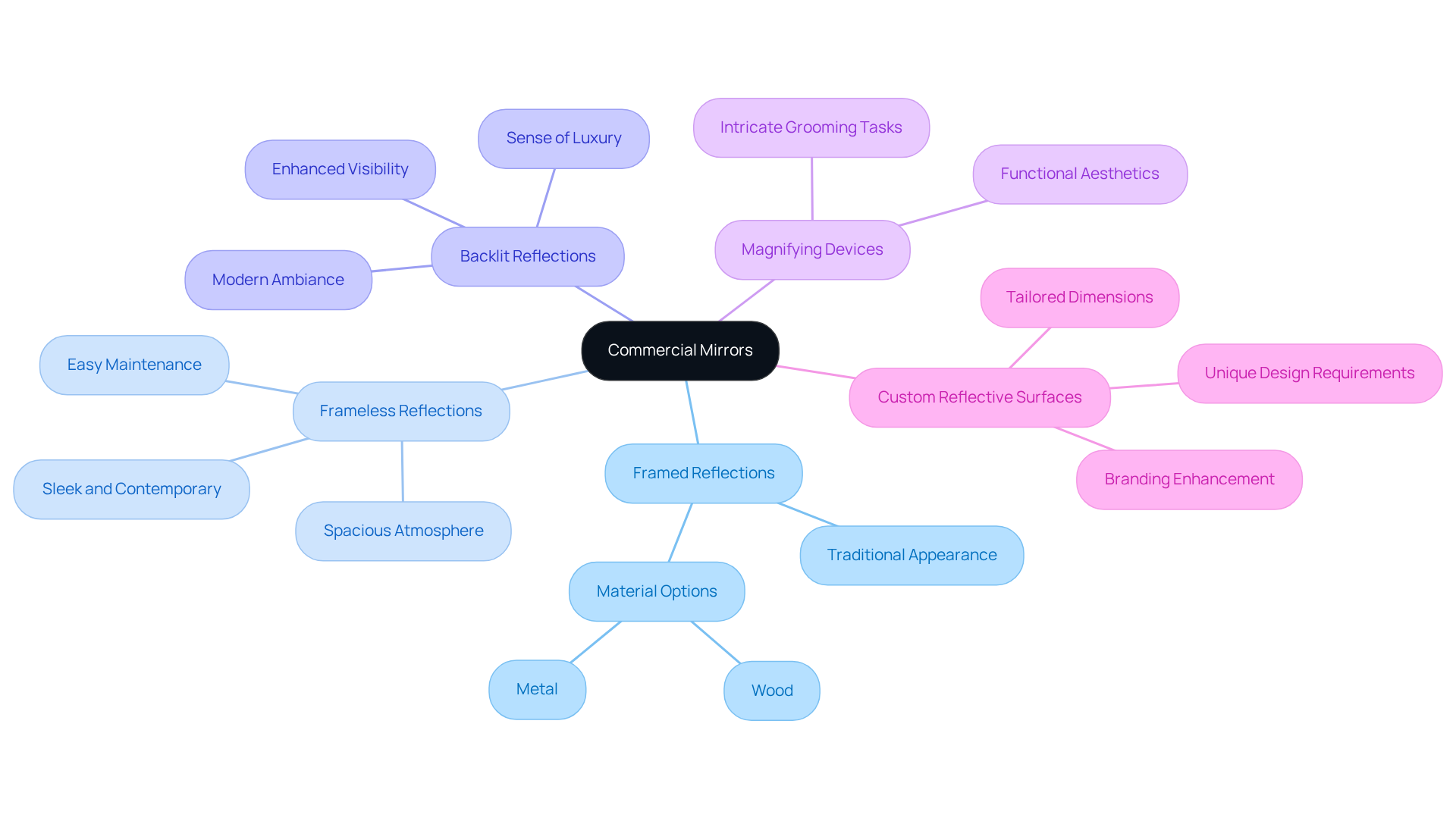Overview
The article delineates four essential steps for effectively selecting mirrors in commercial bathrooms:
- Understanding their significance
- Identifying key selection factors
- Evaluating various types
- Planning for installation and maintenance
These steps underscore the critical balance between functionality, safety, and aesthetics. By ensuring that mirrors not only enhance user experience but also contribute to a clean and inviting atmosphere in high-traffic restroom environments, the article articulates the importance of thoughtful mirror selection.
Introduction
Selecting the appropriate mirrors for commercial bathrooms transcends mere design aesthetics; it is a pivotal element that significantly impacts the user experience in high-traffic environments. These reflective surfaces fulfill essential functions, such as personal grooming, while simultaneously enhancing the overall aesthetics and ambiance of the space, thereby fostering a welcoming atmosphere. Yet, with an array of styles, materials, and installation factors to consider, how can one ensure that the chosen mirrors satisfy both functional and aesthetic requirements? This guide explores the critical steps necessary for effectively selecting mirrors that not only elevate the design but also enhance the usability of commercial bathrooms.
Understand the Importance of Mirrors in Commercial Bathrooms
Mirrors for commercial bathrooms play a crucial role, serving not only as practical tools for personal grooming but also as decorative elements that enhance the overall aesthetic. They create the illusion of a larger space, reflect light to brighten dim areas, and contribute to a clean and inviting atmosphere. In high-traffic settings such as hotels, restaurants, and offices, the use of mirrors for commercial bathrooms can significantly influence user satisfaction and the perception of cleanliness. Therefore, understanding the significance of reflective surfaces is the initial phase in making informed decisions for commercial restroom design.

Identify Key Factors for Selecting Commercial Mirrors
When selecting mirrors for commercial bathrooms, several key factors must be considered:
-
Size: The reflective surface should be proportionate to the space and fixtures. Common sizes include 72" x 100" and 72" x 120". It is essential to ensure that the reflective surface is not wider than the vanity to maintain balance.
-
Material: Opt for durable materials that can withstand moisture and frequent use, especially for mirrors for commercial bathrooms. Suitable options include glass, stainless steel, and acrylic, each offering unique benefits in terms of longevity and aesthetics.
-
Safety: Compliance with safety regulations is paramount, especially in high-traffic areas that include mirrors for commercial bathrooms. It is advisable to consider using tempered glass or shatterproof materials to enhance safety and durability.
-
Accessibility: It is important that mirrors for commercial bathrooms are installed at a height that accommodates all users, including those with disabilities. Adhering to ADA compliance is essential in public facilities to ensure inclusivity.
-
Style: The structure of the reflection in mirrors for commercial bathrooms should enhance the overall bathroom aesthetic, whether it leans towards modern, traditional, or minimalist designs. This consideration not only elevates the visual appeal but also contributes to the overall functionality of the space.

Evaluate Different Types of Commercial Mirrors
When evaluating various types of commercial glass reflections, it is essential to consider how each option can enhance a comprehensive bathroom layout. As Brent Otsuka, Manager of Interior Design at Fentress Architects, notes, The Splash Lab is renowned for its exquisitely crafted products that elevate bathroom aesthetics. They provide a range of mirrors designed to meet diverse aesthetic and functional needs:
- Framed Reflections: These mirrors deliver a traditional appearance and can be constructed from various materials, including wood and metal, adding a distinctive layer of design to the restroom.
- Frameless Reflections: Offering a sleek, contemporary look, frameless reflections create an atmosphere of spaciousness and are often easier to clean and maintain.
- Backlit Reflections: Ideal for creating a modern ambiance, backlit reflections enhance visibility and impart a sense of luxury.
- Magnifying Devices: Particularly useful in environments such as hotels or spas, these tools assist individuals with intricate grooming tasks, ensuring that functionality aligns seamlessly with aesthetics.
- Custom Reflective Surfaces: Tailored to specific dimensions and styles, custom reflective surfaces can fulfill unique design requirements and enhance branding, showcasing The Splash Lab's capability to provide holistic solutions for architects and designers.

Plan for Installation and Maintenance of Mirrors
To ensure the successful installation and maintenance of commercial mirrors, adhere to the following steps:
Installation: Begin by ensuring the wall surface is clean, dry, and flat prior to installation. Utilize suitable mounting hardware that corresponds with the glass's weight and dimensions; for larger glass panels, consider employing wall anchors or brackets. It is essential to position mirrors for commercial bathrooms at eye level for optimal usability, ensuring they are securely fastened to prevent accidents.
Maintenance: Regularly clean mirrors using a non-abrasive glass cleaner and a soft cloth to avoid scratches. Vigilantly check for any signs of damage or wear, particularly around the edges, and address issues promptly to prevent further deterioration. Additionally, ensure that the area surrounding the mirror remains dry to avert moisture buildup, which can lead to mold or damage.

Conclusion
Choosing the right mirrors for commercial bathrooms is essential for creating a functional and aesthetically pleasing environment. These reflective surfaces not only enhance personal grooming experiences but also significantly contribute to the overall ambiance and perception of cleanliness in high-traffic areas. By understanding their importance, stakeholders can make informed decisions that elevate the user experience in commercial restroom design.
Key considerations in selecting mirrors include:
- Size
- Material
- Safety
- Accessibility
- Style
Each factor plays a crucial role in ensuring that mirrors not only meet practical needs but also align with the intended design aesthetic. Furthermore, evaluating different types of mirrors—such as framed, frameless, backlit, and custom options—provides opportunities to enhance both functionality and visual appeal. Proper planning for installation and ongoing maintenance further ensures that these mirrors remain safe, clean, and effective over time.
In summary, the selection of mirrors for commercial bathrooms should be approached thoughtfully, recognizing their multifaceted role in enhancing user satisfaction and overall design. By prioritizing quality and suitability, businesses can create inviting restrooms that reflect their commitment to excellence. Embracing these guidelines will not only improve the bathroom experience but also reinforce the importance of thoughtful design in commercial spaces, ultimately leading to greater customer satisfaction and loyalty.
Frequently Asked Questions
What is the primary function of mirrors in commercial bathrooms?
The primary function of mirrors in commercial bathrooms is to serve as practical tools for personal grooming.
How do mirrors enhance the aesthetic of commercial bathrooms?
Mirrors enhance the aesthetic of commercial bathrooms by creating the illusion of a larger space, reflecting light to brighten dim areas, and contributing to a clean and inviting atmosphere.
Why are mirrors important in high-traffic settings like hotels and restaurants?
In high-traffic settings such as hotels, restaurants, and offices, mirrors significantly influence user satisfaction and the perception of cleanliness.
What should be considered when designing commercial restrooms regarding mirrors?
Understanding the significance of reflective surfaces is crucial for making informed decisions in commercial restroom design.




